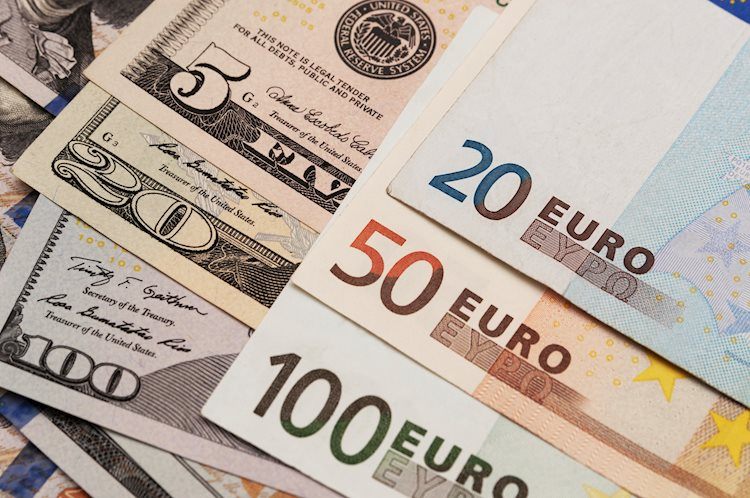- EUR/USD continues to lose ground for the fifth straight day amid sustained USD buying interest.
- Diminishing odds for an aggressive Fed policy easing and geopolitical risks underpin the buck.
- Bets that the ECB will cut rates in October weigh on the Euro and exert pressure on the major.
The EUR/USD pair attracts sellers for the fifth successive day and touches a fresh three-week low, around the 1.1030 area during the Asian session on Thursday. Bearish traders now look to extend the downward momentum further below the 50-day Simple Moving Average (SMA) amid broad-based US Dollar (USD) strength.
Against the backdrop of the upbeat US JOLTS Job Openings survey, the better-than-expected ADP report on Wednesday pointed to a still resilient labor market. This, along with the Federal Reserve (Fed) Chair Jerome Powell’s hawkish tone earlier this week, forced investors to scale back their bets for another oversized rate cut at the November FOMC meeting. Apart from this, the risk of a full-blown war in the Middle East assists the safe-haven Greenback to build on this week’s goodish recovery from its lowest level since July 2023 and climb to a three-week top on Thursday. This, in turn, is seen as a key factor that continues to exert downward pressure on the EUR/USD pair.
The shared currency is further undermined by increased bets that the European Central Bank (ECB) will cut interest rates in October after data released earlier this week showed that the Eurozone inflation fell to 1.8% in September, below the 2% target. ECB Governing Council member Martins Kazaks noted that risks to the economy have become more pronounced and the need for cautious monetary policy adjustments. This contributes to the offered tone surrounding the EUR/USD pair and supports prospects for an extension of this week’s sharp pullback from a 19-month peak.
Even from a technical perspective, acceptance below the 50-day SMA for the first time since early August could be seen as a fresh trigger for bearish traders and validate the negative outlook. Market participants now look forward to Thursday’s economic docket – featuring the final PMI prints from the Eurozone and the US, followed by the usual US Weekly Initial Jobless Claims and the US ISM Services PMI. This, along with speeches by influential FOMC members, will drive the USD demand and allow traders to grab short-term opportunities around the EUR/USD pair.
Euro FAQs
The Euro is the currency for the 19 European Union countries that belong to the Eurozone. It is the second most heavily traded currency in the world behind the US Dollar. In 2022, it accounted for 31% of all foreign exchange transactions, with an average daily turnover of over $2.2 trillion a day. EUR/USD is the most heavily traded currency pair in the world, accounting for an estimated 30% off all transactions, followed by EUR/JPY (4%), EUR/GBP (3%) and EUR/AUD (2%).
The European Central Bank (ECB) in Frankfurt, Germany, is the reserve bank for the Eurozone. The ECB sets interest rates and manages monetary policy. The ECB’s primary mandate is to maintain price stability, which means either controlling inflation or stimulating growth. Its primary tool is the raising or lowering of interest rates. Relatively high interest rates – or the expectation of higher rates – will usually benefit the Euro and vice versa. The ECB Governing Council makes monetary policy decisions at meetings held eight times a year. Decisions are made by heads of the Eurozone national banks and six permanent members, including the President of the ECB, Christine Lagarde.
Eurozone inflation data, measured by the Harmonized Index of Consumer Prices (HICP), is an important econometric for the Euro. If inflation rises more than expected, especially if above the ECB’s 2% target, it obliges the ECB to raise interest rates to bring it back under control. Relatively high interest rates compared to its counterparts will usually benefit the Euro, as it makes the region more attractive as a place for global investors to park their money.
Data releases gauge the health of the economy and can impact on the Euro. Indicators such as GDP, Manufacturing and Services PMIs, employment, and consumer sentiment surveys can all influence the direction of the single currency. A strong economy is good for the Euro. Not only does it attract more foreign investment but it may encourage the ECB to put up interest rates, which will directly strengthen the Euro. Otherwise, if economic data is weak, the Euro is likely to fall. Economic data for the four largest economies in the euro area (Germany, France, Italy and Spain) are especially significant, as they account for 75% of the Eurozone’s economy.
Another significant data release for the Euro is the Trade Balance. This indicator measures the difference between what a country earns from its exports and what it spends on imports over a given period. If a country produces highly sought after exports then its currency will gain in value purely from the extra demand created from foreign buyers seeking to purchase these goods. Therefore, a positive net Trade Balance strengthens a currency and vice versa for a negative balance.
Read the full article here

